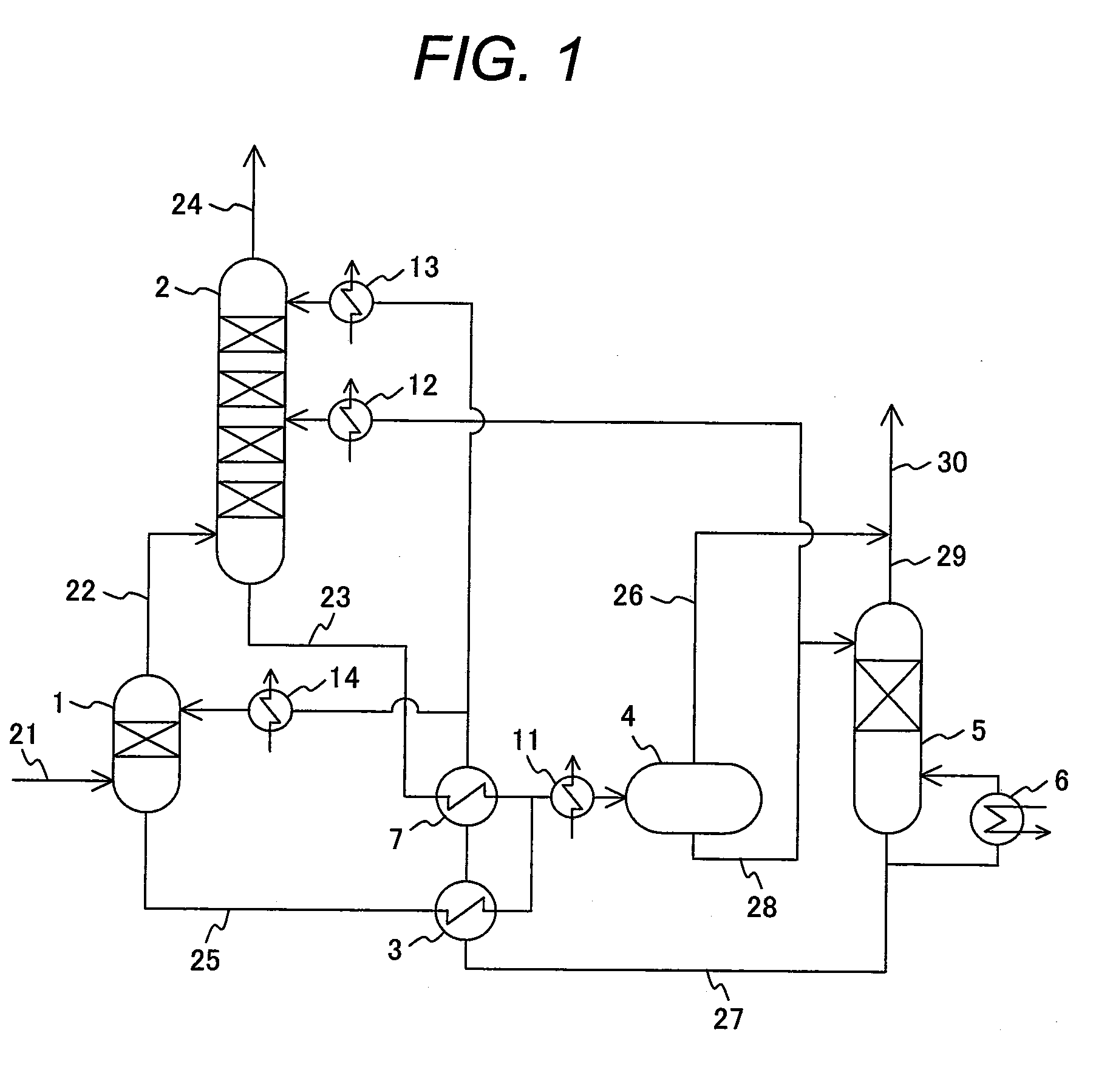Method and device for removing co2 and h2s
a technology of co2 and h2s, which is applied in the direction of liquid degasification, separation processes, gaseous fuels, etc., can solve the problems of increasing the amount of energy consumed for regenerating the rich solution, clogging of pipelines, corrosion of installations such as pipelines, etc., and achieves the reduction of the concentration of co2, the effect of reducing the pressure in the flash drum, and reducing the concentration of co2
- Summary
- Abstract
- Description
- Claims
- Application Information
AI Technical Summary
Benefits of technology
Problems solved by technology
Method used
Image
Examples
first embodiment
[0024]A first embodiment of the present invention will be explained with reference to FIG. 1. FIG. 1 is a block diagram of a device for removing acidic materials in the present embodiment. The present embodiment shows an example in which the present invention is applied to an installation for natural gas purification.
[0025]Natural gas 21 representing feed gas, to which necessary preprocessing and temperature adjustment have been effected beforehand, is supplied to a pre-absorber (first absorber) 1. The feed gas 21 is contacted in a manner of countercurrent with lean solution 27 supplied from a top of the pre-absorber 1, the acidic materials, such as CO2 and H2S, included in the feed gas 21 being absorbed there, and pre-treated gas 22 is exhausted from the top of the pre-absorber 1. On the other hand, rich solution 25 exhausted from a bottom is introduced into a lean / rich exchanger 3 and is heated through heat exchanging with the lean solution 27 introduced into the lean / rich exchang...
second embodiment
[0029]A second embodiment of the present invention will be explained with reference to FIG. 2. FIG. 2 is a block diagram of a device for removing acidic materials in the present embodiment. The present embodiment shows an example in which a secondary absorber (third absorber) 8 is added at a post stage of the absorber 2 in the first embodiment. Only different portions from the first embodiment will be explained.
[0030]The pre-treated gas 22, which is obtained after a part of CO2 and H2S included in the feed gas 21 is absorbed in the pre-absorber 1, is contacted in a manner of countercurrent with the semi-lean solution 28 supplied from the top portion of the absorber 2 in the filling portion of the absorber 2, thereby, a part of the acidic materials, such as CO2 and H2S, included in the pre-treated gas 22 is absorbed, and treated gas 31 is exhausted from the top portion. The treated gas 31 is contacted in countercurrent with the lean solution 27 supplied from the top portion of the se...
third embodiment
[0032]A third embodiment of the present invention will be explained with reference to FIG. 3. FIG. 3 is a block diagram of a device for removing acidic materials in the present embodiment. The present embodiment shows an example in which H2S included in the stripped gas 30 released from the rich solution in the flash drum and the stripper is removed by making use of an adsorbent and highly purified CO2 is recovered. Only different portions from the first embodiment will be explained.
[0033]After being cooled in a cooler 40, the stripped gas 30 including CO2 and H2S is introduced into a knock-out drum 41 where water 50 is removed and stripped gas 51 having lowered water concentration is obtained. The stripped gas 51 is introduced through a valve 62 to a catalytic adsorber 46. In the catalytic adsorber 46, an adsorbent is filled having features to adsorb H2S at a low temperature of 100 to 300° C., and thereafter, to convert the adsorbed sulfur into sulfur dioxide when gas including oxy...
PUM
| Property | Measurement | Unit |
|---|---|---|
| temperature | aaaaa | aaaaa |
| temperature | aaaaa | aaaaa |
| temperature | aaaaa | aaaaa |
Abstract
Description
Claims
Application Information
 Login to View More
Login to View More - R&D
- Intellectual Property
- Life Sciences
- Materials
- Tech Scout
- Unparalleled Data Quality
- Higher Quality Content
- 60% Fewer Hallucinations
Browse by: Latest US Patents, China's latest patents, Technical Efficacy Thesaurus, Application Domain, Technology Topic, Popular Technical Reports.
© 2025 PatSnap. All rights reserved.Legal|Privacy policy|Modern Slavery Act Transparency Statement|Sitemap|About US| Contact US: help@patsnap.com



